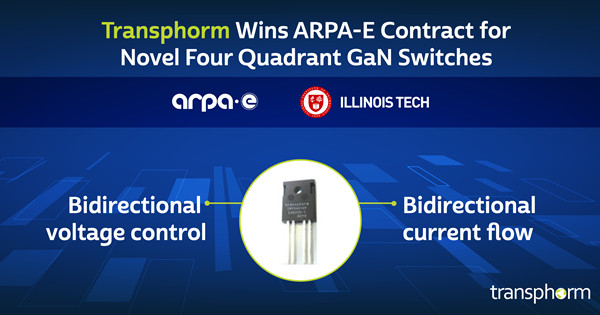
Transphorm, Inc. announced that it has won a U.S. Department of Energy Advanced Energy Research Projects Agency (ARPA-E) contract. The project is part of the ARPA-E CIRCUITS program, carried out through a subcontract with the Illinois Institute of Technology, and includes the provision of a gallium nitride-based four-quadrant bidirectional switch (FQS). These switches can be used in a variety of power conversion applications, such as current source inverters, frequency converters for drives and micro-inverters, matrix switches and solid state circuit breakers and other new applications. The initiative is fueled by Transphorm's deep GaN engineering expertise, particularly its bidirectional GaN products, as well as industry and university interest in further exploring the possibilities of lateral GaN switching applications.
Transphorm's standard lateral GaN field-effect transistor (FET) devices provide bidirectional current flow natively. However, some applications, such as motor-driven current source inverters, frequency converters, and matrix converters, also require bidirectional voltage control to effectively manage power flow in the power system. The traditional way to implement this functionality is to place two FETs in series, using the device's body diode to direct and control current flow, or two insulated gate bipolar transistors (IGBTs) and two diodes, thus requiring four devices.
Also known as a true bidirectional switch, FQS replaces the approach of two FETs or two IGBTs + two diodes with a single device capable of bidirectional voltage control and bidirectional current flow. FQS uses two gates to block voltage of any polarity or current flow in any direction. Moreover, as a single device, FQS can reduce the number of parts required to achieve the desired effect, resulting in higher power density, improve reliability, and reduce overall system cost.
Tom Jahns, professor emeritus at the University of Wisconsin-Madison and fellow of the National Academy of Engineering (NAE) and the Institute of Electrical and Electronics Engineers (FIEEE), said: "Seeing gallium nitride-based bidirectional switches getting closer to commercial mass production, Very exciting. Power electronics engineers have been anxiously awaiting the availability of MOS-gate bidirectional switches as they are key devices in enabling promising power converter topologies that can improve efficiency, power density and performance in many applications. There are exciting opportunities in fault tolerance. They are also expected to greatly improve the commercial viability of a number of new products, including solid-state circuit breakers and integrated motor drives, which FQS can enable compared to currently used silicon-based switches More compact and efficient."
Dr. Rakesh Lal, Technical Fellow at Transphorm, said: "Based on the adoption of GaN devices today, the time is ripe to bring FQS bidirectional devices to market. Because the voltage blocking region can be shared, lateral GaN technology enables the fabrication of compact FQSs. chip, which is not possible with vertical power device technology using silicon or silicon carbide, giving gallium nitride FQS a clear advantage in both performance and cost. With our FQS, users can get true The two-way nature of the future. We believe that the partnership driven by the CIRCUITS program will inspire the emergence of the next generation of power conversion products.”